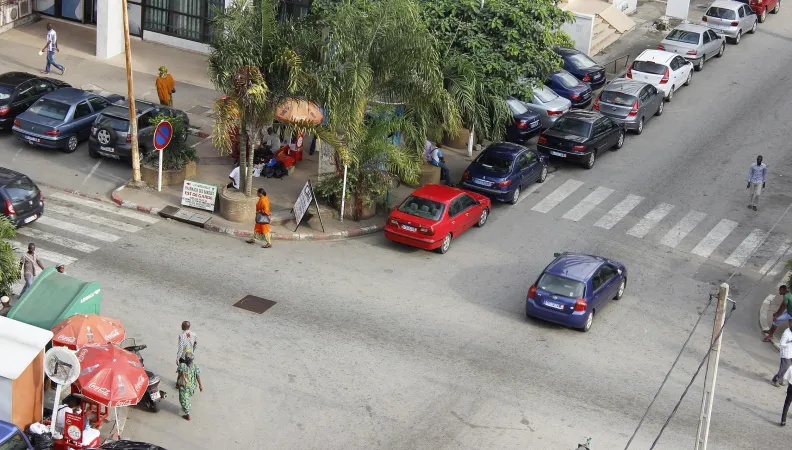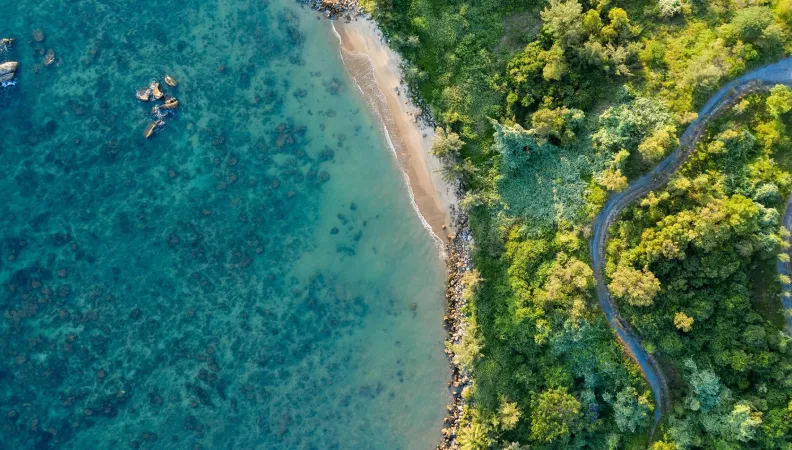 Colombia has demonstrated its commitment to climate issues through its commitment to implementing its nationally determined contribution (NDC) under the Paris Agreement. Developing an ecologically and economically sustainable development trajectory is a significant challenge, which the GEMMES Colombia project supports through sound methodology and policy-based dialogue.
Colombia has demonstrated its commitment to climate issues through its commitment to implementing its nationally determined contribution (NDC) under the Paris Agreement. Developing an ecologically and economically sustainable development trajectory is a significant challenge, which the GEMMES Colombia project supports through sound methodology and policy-based dialogue.
Context
Highly exposed to the effects of climate change and to the degradation of natural resources, Colombia is strengthening its climate policy, considering a green growth strategy, particularly since the 2014-2018 National Development Plan. Nevertheless, the country's dependence on raw material exports and its strong integration into international financial markets generate monetary, financial and commercial vulnerabilities.
AFD is supporting Colombia in its efforts to tackle climate change through the GEMMES Colombia project, which is part of the third climate policy loan since 2018. The GEMMES programme, by integrating the impact of climate change into its forecasts, is developing a general theoretical model on the one hand, and national models applied to concrete cases and adapted to the characteristics of each country on the other, including the GEMMES Colombia model.
About GEMMES: AFD and Macroeconomic Modelling Tools for the Ecological Transition
Goal
The GEMMES Colombia project, which is fully in line with AFD's commitment to strong sustainability, aims to :
- Highlight potential fragilities in the Colombian economy through a better understanding of the interactions between fiscal, monetary and trade policies and the country's NDC objectives;
- Identify the opportunities generated by the energy transition in Colombia: structural changes and financing methods under the best possible conditions;
- Quantifying the macroeconomic impact of NDC-related investments, particularly in the financial and tax sectors;
- Promoting public policy dialogue on Colombia's energy transition:
- Providing a decision-making tool for decision-makers on climate policies, with a view to limiting the consequences identified without compromising the implementation of Colombia's NDC objectives;
- By promoting the appropriation and sustainability of the GEMMES modelling tool within the partner institutions.
Read also: Diego Guevara: "We cannot develop sustainably if we lack the resources"
Method
In addition to its specific transdisciplinary approach, which makes this project one of the few to integrate the notion of strong sustainability, the originality of GEMMES lies in its consideration of macro-financial imbalances and the impact of the low-carbon transition on all elements of the balance of payments.
Moreover, GEMMES Colombia is part of a partnership initiative that is organised around two phases:
- The first phase is based on the development of the model and the macroeconomic analysis of the Colombian NDC trajectory, in partnership with the National Planning Department (DNP) and the Ministry of Finance (MHCP) supported by AFD's modelling teams.
- The second is intended to ensure the sustainability of the project after the end of the support, with the analysis by the National University of Bogota (UNAL) of the interactions between trade, fiscal and monetary policies and the NDC trajectory, as well as the training of students in sustainable development through the Catedra course as well as in the GEMMES methodological approach.
Results
The first results of the project have been presented at the virtual congress "Conexión DNP: transfiriendo conocimiento para innovar" on 2 and 3 December 2021. The project partners expressed their satisfaction, with the MHCP showing a particular interest in modelling after a year of remote work due to the Covid-19 pandemic.A university course on sustainable development (Catedra), partly based on the results of the GEMMES Colombia project, was launched on 7 March 2022 at UNAL to raise awareness of the issue.
In March 2022, a university course on sustainable development (Catedra), partly based on the results of the GEMMES Colombia project, was launched at UNAL. As a continuation of this initiative, a second course on the modelling of ecological transitions in the Global South was given in 2023.
The GEMMES Colombia model, enriched by academic expertise and integrated into decision-making processes through Colombian ministries, has become a key tool for public policy dialogue. These exchanges continue thanks to the GEMMES Strategic Committee, composed of the Ministry of Finance and Public Credit (MHCP), the National Planning Department (DNP), the Ministry of Mines and Energy (MME) and the Banco de la República.
At the request of the Colombian authorities, GEMMES was added to the MHCP macroeconomic models in 2023 and was coupled to the Energyscope energy model, an energy assessment and planning tool. Ownership of the model continued in 2024 with executive training on the use of the model provided to MHCP officials.
The research resulted in a collective book published in June 2024, presenting the scientific findings and policy recommendations from the GEMMES Colombia project: Modelling low-carbon transitions in Colombia: Macrofinancial opportunities and risks project. This work also led to the launch of a new project: the creation of a serious game to support multi-stakeholder dialogue around the NDC in Colombia.
Watch the replay of the GEMMES Colombia book launch (in Spanish)
Lessons learned
The GEMMES Colombia model, by developing scenarios on fossil fuel exports and alternative policies for the 2023-2050 period, as well as financing scenarios of the NDC trajectory, contributes to informing decision-makers in their political strategy to fight global warming. The model also allowed the National Planning Department (DNP) to analyze the consequences of economic shocks such as the loss of the country’s investment quality, the reduction of coal exports or the bankruptcy of Evergrande in China.
The conclusion is clear: a diversification of the production structure and a transformation of public finances are essential if Colombia is to meet the challenges of a global low-carbon transition and ensure its own energy transition. The GEMMES model highlights the importance of using a combination of private investment and public green bonds to finance Colombia's climate ambition.
Download the publications related to GEMMES Colombia:
- Can Colombia cope with a global low-carbon transition? (June 2023)
- Low-carbon transition and global macroeconomic vulnerabilites: A multidimensional approach in tracing vulnerabilities and its application in the case of Colombia (July 2023)
- Modelling low-carbon transitions in Colombia: Macrofinancial opportunities and risks (July 2024)
Contact:
- Antoine Godin, economist at AFD, head of the Macroeconomic Modelling Unit
Contacto:
- Antoine Godin, economista, responsable de la célula de modelización macroeconómica GEMMES, AFD
 Côte d'Ivoire, whose current electricity production is largely based on natural gas, has affirmed its commitment in favor of the energy transition. The GEMMES Côte d'Ivoire project studies the interactions between the productive, financial and ecological spheres through macroeconomic modelling, thus constituting a real tool for Ivorian policy makers.
Côte d'Ivoire, whose current electricity production is largely based on natural gas, has affirmed its commitment in favor of the energy transition. The GEMMES Côte d'Ivoire project studies the interactions between the productive, financial and ecological spheres through macroeconomic modelling, thus constituting a real tool for Ivorian policy makers.
Context
Elaborating development policies in line with the principles of strong sustainability is a complex issue because of the tensions that may exist between different Sustainable Development Goals. The desire to integrate 42% of renewable energies in Côte d'Ivoire's energy mix by 2030 therefore requires a reflection on the possible sustainable development trajectories, a subject at the heart of the GEMMES Côte d'Ivoire project.
This project is part of AFD's modelling work, that integrates climate dynamics, both adaptation and mitigation, into macroeconomic forecasts to inform public policy choices in this area. AFD is developing a general theoretical model on the one hand, and national models applied to specific cases and adapted to the characteristics of each country (including the GEMMES Côte d'Ivoire model) on the other hand.
Find out more about GEMMES: AFD and Macroeconomic Modelling Tools for the Ecological Transition
This collaboration between AFD, the Ministry of Planning and Development of Côte d'Ivoire and Mines ParisTech is one of the components of the memorandum of strategic dialogue, which aims to develop research activities, their dissemination, as well as their synergies with public policies.
Goal
GEMMES Côte d'Ivoire's first goal is to better understand the interactions between the economy and socio-economical aspects. It focuses on the macroeconomic impacts of the energy transition and their ability to create favorable conditions for poverty reduction.
One of its specificities is that it aims to foster dialogue on the ecological transition between researchers and policy makers, both at national and international levels. GEMMES Côte d'Ivoire aspires to propose a tool to facilitate political decision-making, proposing transition trajectories in favor of climate. It could then provide elements contributing to the definition of an energy transition strategy for 2050 in line with Côte d'Ivoire’s poverty reduction and climate goals.
More broadly, GEMMES Côte d'Ivoire is helping to consolidate AFD’s position as a main stakeholder on low-carbon transition and strong sustainability.
Method
GEMMES Côte d'Ivoire develops a multidimensional and transdisciplinary approach focused on the effects of the energy transition. The project is based on modelling exercises:
- Techno-economical modelling of the energy system, developed by Mines Paris Tech
- Macroeconomic modelling, developed by AFD and the Ivorian think tank CAPEC
The methodological framework of GEMMES has been adapted to meet the characteristics of the Ivorian economy. A particular focus was placed on the stability of the trade balance and public debt. Moreover, the coupling between the energy model and the macroeconomic model allows to perceive the interactions between the dynamics of energy transition and macro-financial stability. In addition, coupling can highlight the benefits of an ambitious energy transition in terms of external sustainability and job creation.
Results
Three scenarios quantifying the long-term macroeconomic effects of the energy transition have been established. As a result, the development of renewable energy could reduce the average production cost by 20% under certain scenarios, notably through increased investment in the solar battery sector.
The development of this sector would also generate positive socio-economic impacts, concerning growth, employment and the trade balance, while increasing bioelectricity generation capacity improves the income of 4 million people in rural areas. This environment is then more favourable to the deployment of specific policies to fight poverty.
Lessons learned
The project has conducted the first GEMMES modelization exercise incorporated in the ongoing public policy dialogue between AFD and Ivorian public stakeholders. The project has provided the Ivorian government with models highlighting the opportunities and contradictions within the country's trajectory, between the possible energy choices, the environmental agreements to be considered and the financial implications of each scenario.
Contact :
- Antoine Godin, economist at AFD, head of the GEMMES Macroeconomic Modelling Unit
 As part of the ECOPRONAT research program, AFD is developing methodologies to assess the environmental sustainability of a territory, to contribute to the structuring of international standards defining “good ecological condition” of an ecosystem. Among these methodologies is the ESGAP (Environmental Sustainability Gap) framework, tested in Vietnam and Kenya.
As part of the ECOPRONAT research program, AFD is developing methodologies to assess the environmental sustainability of a territory, to contribute to the structuring of international standards defining “good ecological condition” of an ecosystem. Among these methodologies is the ESGAP (Environmental Sustainability Gap) framework, tested in Vietnam and Kenya.
Context
Public actors need to monitor the state of the environment in order to assess the effectiveness of their actions, prioritize policies and management measures, and thus objectively establish their contribution to the conservation of natural capital. To do so, they must be able to rely on scientific standards enabling them to define the thresholds from which environmental functions can be considered sustainable.
The ESGAP (Environmental Sustainability Gap) is an innovative tool that assesses the state of a territory’s environmental functions and their level of sustainability. For all critical components of natural capital in the territory concerned (air or water quality, pollution, forest resources, fisheries, etc.), this indicator calculates the difference between their current state and a state that would be sustainable (that is, a state compatible with a sustainable functioning of the processes necessary for the preservation of life, human activities and well-being). This allows the calculation of an “environmental sustainability gap”, which highlights the path that remains to reach the stage of environmental sustainability. This can then serve as a guide for public policy to estimate and preserve the natural state of a given territory.
Within the framework of the ECOPRONAT research program, AFD wishes to develop methodologies for assessing strong sustainability, that is to say adopting demanding criteria concerning the non-substitutability of natural capital by other forms of capital (physical and other) in a territory or country. AFD would also like to promote their use in international settings and contribute to the emerging international standards on the good ecological status of ecosystems.
Goal
This project aimed to test the relevance of the ESGAP framework in developing countries, where not all data on natural capital are always available. In collaboration with the United Nations Environment Programme (UNEP), Paul Ekins' team at University College London (UCL) supported two pilots of this indicator in Vietnam and Kenya.
These pilots were carried out by teams of experts both from national research institutes responsible for monitoring and reporting environmental data: the Kenya National Environmental Management Authority (NEMA) and the Institute of Strategy, Policy on Natural Resources and Environment (ISPONRE) in Vietnam. This work enables better integration of strong environmental sustainability principles into global environmental assessments.
These pilots also sought to better document the challenges of strong environmental sustainability in the series of Measuring Progress reports published by UNEP.
Method
The ESGAP framework is based on a dashboard that provides information on changes in the functional state of 23 components of the environment, focusing on the differences between these changes and the objectives of maintaining or achieving “good ecological status”. These components cover the four main categories of critical and essential environmental functions: the provision of resources, the reprocessing of pollution, biodiversity and human health. The scores of the 23 components are then aggregated to form a synthetic indicator and a dynamic indicator.
Results
The two pilots revealed the general lack of standards for maintaining biodiversity in both countries, as well as significant gaps in environmental regulation, both in Kenya and Vietnam. The lack of historical reference points to measure the good state of the environment is a serious obstacle to the establishment of protection policies and prevents the debate on narratives and development trajectories respectful of the natural heritage.
Moreover, the analysis shows a worrying situation in both Kenya and Vietnam about pollution of natural environments, despite the very limited availability of data on these issues. In Kenya, the results are rather good on natural resources, but many essential and critical contributions of natural capital to human well-being and health are greatly degraded, both for water and air quality, as well as for access to natural amenities. In Vietnam, fish resources, soil erosion, and air and water pollution appear to be the most degraded dimensions.
According to ISPONRE and NEMA, the ESGAP framework has great potential as a tool for communicating the state of a territory and for monitoring public policies in both countries. It offers a framework for broadening the range of topics covered by public policies and proposes a high-quality standard for the establishment of environmental sustainability assessment frameworks.
This research project also supported a flagship UNEP report on the environmental content of the Sustainable Development Goals (SDGs), Measuring Progress: Environment and the SDGs, which incorporates the lessons learned from these two ESGAP pilots. This has shown that, of the 231 SDG monitoring indicators, 77 can be linked to an environmental theme from near or far, but that only 11 of them really describe the state of the environment.
Download the reports:
- Environmental Sustainability in Kenya: A Case Study in the ESGAP and SESI (June 2022)
- Environmental Sustainability in Vietnam: A Case Study in the ESGAP and SESI (June 2022)
Lessons learned
Initial feedback indicates that the ESGAP pilots need to be backed up by real capacity-building exercises of the administrations in charge of environmental monitoring and natural capital management, in order to hope to improve environmental diagnostics in the long term.
The concepts of “scientific standards” and “diagnosis of the state of natural capital contributions” also need to be refined, explained and adapted to the available contexts and data: if, ideally, these standards are derived from international frameworks and legitimated at the national level, often alternative indicators must be used to adapt the standards to different contexts.
These lessons complement those from a pilot of the ESGAP indicator, led by AFD and WWF in New Caledonia. Following another ECOPRONAT call for projects, two more ESGAP studies are underway:
- A first study aims to develop indicators for biodiversity and the health of natural ecosystems, as well as an ESGAP methodology in South Africa and Colombia.
- A second study aims to refine socio-economic indicators and study the relationship between the economy and the environment, with Vietnam as a case study.
Contact:
- Oskar Lecuyer, research officer at AFD
